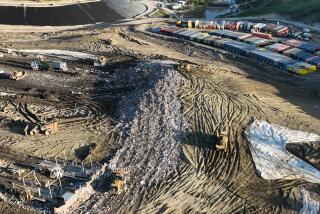Dumped Oil Wastes Suspected in Endangered Condor’s Death : Wildlife: Biologists say the bird may have drunk an antifreeze mixture used by Ventura County flood control employees.
Oily wastes dumped by Ventura County flood control employees may have killed an endangered California condor last fall, authorities said Tuesday.
County flood control officials acknowledge that for three decades, engineers routinely have poured oil and antifreeze from remote rain gauges onto the ground in the Sespe Condor Sanctuary.
And federal biologists said the toxic mixture could have killed 15-month-old Chocuyens, one of two baby condors released into the wild in January, 1992.
Chocuyens (pronounced Cho- KOO-yenz) was found dead Oct. 8 about a mile south of Pyramid Lake Dam, or six miles north of the Sespe Condor Sanctuary. Toxicology tests confirmed that the male vulture died of kidney failure after drinking ethylene glycol, a fluid used in antifreeze.
On Tuesday, flood control officials said they have stopped dumping rain gauge wastes, and county health officials said they have launched an inquiry into whether the disposal practices violated state or federal laws.
“You can’t walk out and dump a quart of oil on a vacant lot next door,” said Donald Koepp, director of the county’s environmental health division. “The laws are no different for you or me or a business or a public entity. There are no exceptions.”
For the past 34 years, county flood control engineers have routinely dumped about a quart of antifreeze mixed with water and oil during annual maintenance of the gauges, said Bill Minger, a flood control hydrographer.
But top officials ordered employees to stop the practice late last year after environmentalists and federal biologists told them that the condors in the sanctuary north of Fillmore could drink the poisonous mixture and die.
“I said we’re going to have to do it another way,” said Dolores Taylor, senior hydrologist in the flood control district. “We’re not going to be very popular if birds are dying and it looks like it’s our fault.”
Fish and Wildlife officials theorized at the time of Chocuyens’ death that the antifreeze was flushed from a car or vehicle alongside a road or creek near popular boating or off-road vehicle recreation areas in the eastern end of Los Padres National Forest or the western tip of the Angeles National Forest.
But a U. S. Fish and Wildlife Service biologist said Tuesday that Chocuyens could have died after ingesting antifreeze from one of flood control’s 19 rain gauge sites in the Los Padres National Forest, which encompasses the sanctuary.
“We haven’t ruled anything out,” said Robert Mesta, project leader with the condor program. “I don’t know if we’ll ever be able to pin it down.”
Mesta said he told flood control officials that their dumping practices may present a hazard to wildlife shortly after Chocuyens’ death. Fish and Wildlife officials learned of the practice from forest rangers, Mesta said.
About the same time, a Fillmore environmentalist and former flood control employee asked county officials if they were still dumping wastes, Taylor said. “He remembered one gauge where it was rock and (the wastes) didn’t soak in,” she said.
Based on those concerns, flood control officials in November instructed engineers to carry out wastes rather than dump them, she said.
The gauges are hollow pipes designed to collect rainwater over a long period of time, said Minger, who supervises maintenance and collections for the gauges. Antifreeze was added to the 12-foot-high pipes to prevent them from freezing and cracking, and oil was added to ward off evaporation, he said.
Each year about Oct. 1, the start of the rain season, hydrographers from the flood control district visit the gauges to get rid of the old wastes and add new fluid, he said. This year, the gauges were serviced about a week before Chocuyens was found dead.
The toxic mixture was dumped in the same area every year, Minger said.
Cynthia Leake, vice president of the Environmental Coalition of Ventura County, said she questioned flood control officials about the dumping practice immediately after she learned of it in January.
“I was appalled,” Leake said. “My concern was not only for the condors, but for the toxic buildup in the soil.”
County environmental health officials said they too are concerned. Koepp said oil and concentrated forms of antifreeze are considered hazardous wastes and federal and state laws have banned the dumping of hazardous wastes since the mid-1980s.
“Maybe they didn’t have knowledge of the laws, but that doesn’t exempt them,” he said.
Flood control officials are cooperating with Koepp to determine if laws were broken, Taylor said. Soil samples will be taken at each dump site and tested for toxicity, she said.
“My hope is it will turn out that the concentration was not very strong,” she said. “But in the worst case, we will have to clean up (each site).”
Taylor said she was not aware that the dumping practices may have violated environmental laws and threatened the condors.
“We had no idea we might be in violation of the law,” she said. “We stand warned.”
Six more condor chicks were released into the Sespe sanctuary in December, joining 20-month-old Xewe (pronounced Gay-wee) as the only seven members of the endangered species now in the wild. Biologists plan to release additional chicks bred in captivity each year until they are no longer considered endangered, a process that could take two decades, officials have said.
More to Read
Sign up for Essential California
The most important California stories and recommendations in your inbox every morning.
You may occasionally receive promotional content from the Los Angeles Times.










